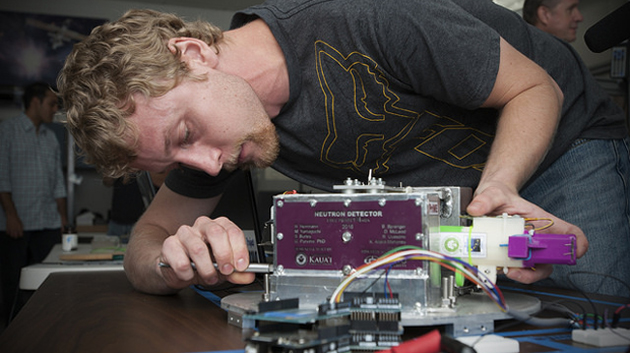
Project Imua team members have held several successful mission simulations of their second payload named PrIME for Project Imua Multiple Experiment.
Project Imua (to move forward in Hawaiian) is a joint faculty-student enterprise of four University of Hawaiʻi Community College campuses to develop small payloads for spaceflight while providing undergraduates with hands-on learning in STEM fields. This is reflected in the experiments the students created to be flown into space:
- A neutron-gamma ray detector designed and fabricated by Kauaʻi CC, a prototype, which is being tested for a possible future orbital flight.
- An innovatively powered rocket designed by Windward CC and fabricated using a 3-D printer. ScubeR (Super Simple Sublimation Rocket) will be deployed at the peak of the NASA sounding rocket’s flight.
- Honolulu CC has configured two on-board Mobius Action cameras to record video and pictures of the flight and has selected a motion tracker to record g-forces.
- The Kapiʻolani CC team developed the payload’s interface boards for power and conditioning and data processing and transfer, as well as the housing for these circuits.
“The neutron detector that Kauaʻi CC helped build is the first of its kind,” said Kauai CC student Kaina Allard-Mahoney. “It’s going into space, it was developed by real students at a community college and it’s going on a NASA rocket. Great project. Great experience.”
An exciting first
Windward CC professor and Project Imua Manager Joseph Ciotti says their rocket is another first. He said, “The propellant we are using is what people normally use for mothballs. It’s naphthalene and that will turn from a solid to a gas and propel the rocket, and this is the first time that this is being done in space. So, it is kinda exciting!”
This is the second of two years for the project funded with a half-million dollar NASA grant awarded to the Hawaiʻi Space Grant Consortium, which includes $200,000 in student internships.
Windward student Cale Mechler is a two-year team member who got to see the launch of the first Project Imua payload from NASA Wallops Flight Facility in Virginia in August of 2015.
“This has been an awesome experience,” said Mechler. “Being able to do the same things that any company that wants to fire a rocket with NASA goes through—we went through all the same stages.”
Those stages included having their experiments launched into space, having the rocket retrieved and returned to NASA and opening up their payload to retrieve the data from their experiments.
“What’s great about it is it provides students an opportunity hands-on, project-based, to learn STEM-oriented projects and get familiar with careers in aerospace engineering,” said Ciotti.
A team of three mentors and eight students will return to Wallops Flight Facility in Virginia to conduct final tests for integration and launch on a NASA sounding rocket. This sub-orbital flight, which will carry the payload to an altitude of approximately 100 miles during its 15-minute mission, is scheduled for launch on August 16, 2016.

360-degree virtual reality views of the PrIME payload and the sublimation rocket ScubeR
- PrIME with ScubeR attached
- PrIME without ScubeR (after it is released)
- ScubeR + Hammerhead (horizontal orientation)
- ScubeR + Hammerhead (vertical orientation)
- Stats and overhead view of PrIME and ScubeR
—Images courtesy of Joseph Ciotti
More about the first Project Imua launch
NASA rocket launches UH’s scientific payload into space, August 12, 2015
Project Imua takes education out of this atmosphere, July 16, 2015
Project by UH Community College students space bound, June 12, 2015
—By Kelli Trifonovitch

